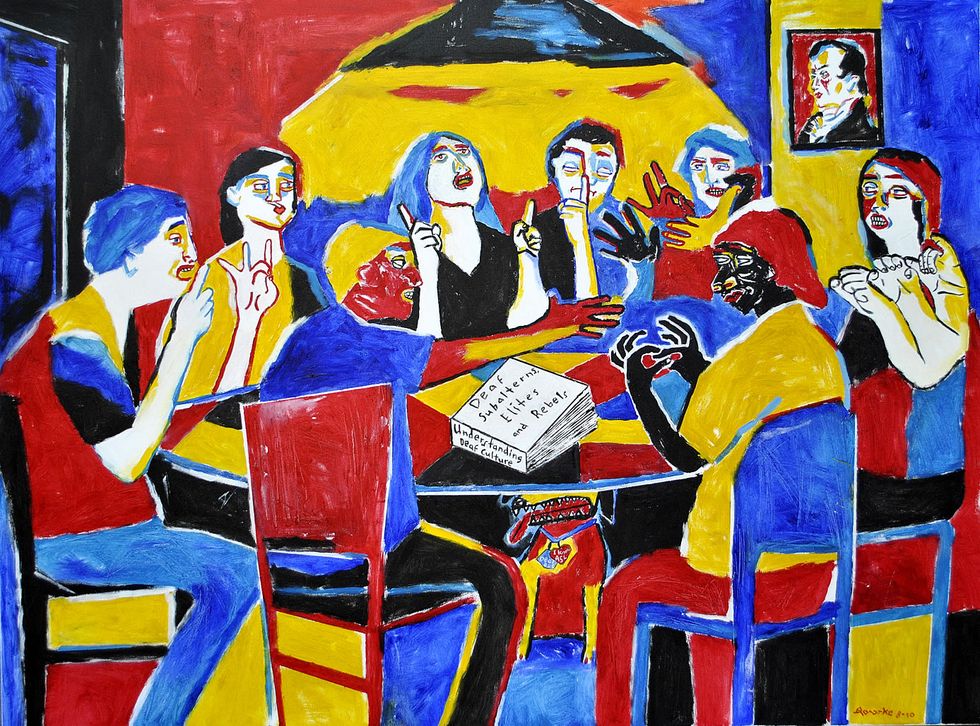We’ve seen how ASL was born. We’ve seen how ASL has progressed over the years. We’ve seen how complex ASL grammar is. Now, it’s time to look at the “socio” part of sociolinguistics.
In 1972, a Gallaudet University research study found that about half a million people used ASL as a native language; this doesn’t even include the number of people who learned ASL as a second language. Though an exact number is unknown, we can safely assume that there are even more ASL users today. In 2012, another research study found that almost two hundred million people in the US alone were deaf or hard-of-hearing. These people, coupled with the growing deaf education system, account for the growing us
age of ASL.
This is a large number. Deaf communities, found all over America, are tight-knit and act as a second family to many members. Like the sign language teacher at my school said, “the deaf community is overlooked. It’s because they’re an American community. They’re not necessarily coming from another country, and because of that, they tend to get overlooked as an entire community.”
Professor Cathy L. Haas of Stanford University has attested to this. When I was at camp over the summer, we attended a guest lecture from Professor Haas. Haas, the ASL professor at the university, was deaf; we listened to her words through two interpreters who came with her.
After the lecture, we watched some documentaries on deaf culture and the struggles that deaf communities face. Our Sociolinguistics professor and TAs reflected with us on what we had discussed; I can say for myself that, through the lectures, documentaries, and discussions, I learned a lot about what it means to be part of the deaf community.
It seems as though deafness is an “ethnicity”--beyond just a culture. Rather than being defined by a skin color, like most ethnicities are, the “ethnicity” of deafness is defined by being deaf or hard of hearing; deaf culture doesn’t see race as a barrier because members of the culture relate to each other by their deafness.
People in the deaf community are affected by their familial relationships. For example, a child of deaf parents is called a CODA (Child of Deaf Adults). Hearing children of deaf adults are H-CODA, while deaf children of deaf adults are called D-CODA. On top of that, deaf people may have hearing siblings or hearing spouses. Because of these relationships between the hearing and deaf cultures (just like how different ethnicities interact and have relationships with each other), a mutual understanding is critical.
If someone is a hearing child of deaf parents (H-CODA), he or she would probably grow up learning sign language at home; at school, spoken language may be taught. This might put the hearing child in a strange limbo between “ethnicities,” where the child is caught between the hearing and deaf communities. Since the deaf community is so tight-knit, members usually see each other as family.
The H-CODA’s parents may be encouraged by other deaf members to integrate their child into the deaf community; certainly, the child may want to grow up with the same community as his or her parents. However, this would clash with the child’s interactions with the hearing community as deaf members could chastise the child for being hearing--or hearing members could see the child as strange for wanting to be part of the deaf community.
Hearing siblings and hearing spouses of deaf people may also be put in this situation. They want to become immersed with their loved ones’ deaf friends, but the line between hearing and deaf worlds is often hard to cross. This is just one reason why sign language is incredibly important, since it provides a bridge to connect the two communities.
In this day and age, scientists have created many devices--including hearing aids and cochlear implants--for deaf children (and even deaf adults) to be able to hear better. However, these are incredibly controversial in both the hearing and the deaf worlds.
In deaf communities, hearing aids and cochlear implants can be seen as a way to get out of the deaf world. This can become an issue, as most deaf people embrace their deafness. The hearing aids may be interpreted as a threat to deaf culture; in extreme cases, the deaf community may react negatively to these hearing aids because they feel that the hearing world looks down upon the deaf.
This doesn’t even take into account the fact that operations such as cochlear implants can be dangerous for both children and adults. In addition, deaf adults often have a harder time adjusting to a newly opened hearing world because they have to learn spoken language at a later stage in life.
Some deaf parents may want their deaf child to have the ability to hear with a hearing aid; some deaf parents would rather raise their child the way that they were raised, as there exists a welcoming deaf community for their child to grow and learn in. Either way, there is no one “correct” method in which to raise a child.
As you can see, there are many factors to take into account when comparing the hearing world to the deaf world. Before Professor Haas’ lecture, I had not known just how important ASL was to both worlds.
Language and communication--and the willingness to learn and communicate--are truly part of the solution to human differences. Once we learn about others’ lifestyles through their languages, we can tear down the wall between different upbringings and cultures.
I hope these last few sections on ASL and deaf culture have been meaningful; stay tuned for next week’s installment!






















